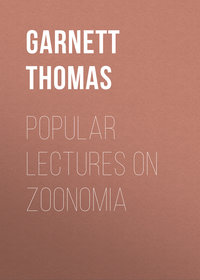
Popular Lectures on Zoonomia
There are several other viscera besides those I have described, which are subservient to digestion; among these may be mentioned the liver, gall bladder, and pancreas. The liver is the largest gland in the body, and is situated immediately under the diaphragm, principally on the right side. Its blood vessels that compose it as a gland, are the branches of the vena portarum, which, as I mentioned in the last lecture, enters the liver and distributes its blood like an artery. From this blood the liver secretes the bile, which is conveyed by the hepatic duct, towards the intestines: before this duct reaches the intestines, it is joined by another, coming from the gall bladder: these two ducts uniting, form a common duct, which enters the duodenum obliquely, about four inches below the pylorus of the stomach.
The gall bladder, which is a receptacle of bile, is situated between the stomach and the liver; and the bile which comes from the liver, along the hepatic duct, partly passes into the duodenum, and partly along the cystic duct into the gall bladder. When the stomach is full, it presses on the gall bladder, which will squeeze out the bile into the duodenum at the time when it is most wanted.
The bile is a thick bitter fluid, of a yellowish green colour, composed chiefly of soda and animal oil, forming a soap; and it is most probably in consequence of this saponaceous property that it assists digestion, by causing the different parts of the food to unite together by intermediate affinity. When the bile is prevented from flowing into the intestines, by any obstruction in the ducts, digestion is badly performed, costiveness takes place, and the excrements are of a white colour, from being deprived of the bile. This fluid, stagnating in the gall bladder, is absorbed by the lymphatics, and carried into the blood, communicating to the whole surface of the body a yellow tinge, and other symptoms of jaundice.
Конец ознакомительного фрагмента.
Текст предоставлен ООО «ЛитРес».
Прочитайте эту книгу целиком, купив полную легальную версию на ЛитРес.
Безопасно оплатить книгу можно банковской картой Visa, MasterCard, Maestro, со счета мобильного телефона, с платежного терминала, в салоне МТС или Связной, через PayPal, WebMoney, Яндекс.Деньги, QIWI Кошелек, бонусными картами или другим удобным Вам способом.
1
[FIGURE] Suppose AC to be a lever, held in equilibrio by the force B and weight W, then the whole momentum exerted at B must be equal to that at W, but the forces will be different. For B x AC = W x AB, and if AC = 10AB, then a force equal to ten times the weight to be raised must be exerted by the muscle. Hence we see, that in the actions of muscles there is a loss of power, from their insertions being nearer the fulcrum than the weight. For example, suppose the deltoid muscle to act and raise a weight of 55 lb.: the weight of the arm is 5 lb., and the distance of its insertion is only 1/3 of the arms length, hence the force exerted must be (55 + 5) x 3 = 180 lb.
[FIGURE] But by this contrivance we gain a greater extent of motion, and also a greater velocity, and both with less contraction. Let A be the centre of motion, or articulation; B the insertion of a muscle, and AC the length of the lever or bone; then, by a contraction only equal to B_b_, C is carried through C_c_, which is to B_b_ as AC to AB. It is obvious also, that the velocity is greater, since C moves to c in the same time as B to b.
A loss of power is likewise occasioned by the obliquity of the muscular action, and the oblique direction of the fibres.
For, in this case, there is a compound of two forces, and a consequent loss of power: for the forces are proportioned to the two sides of a parallelogram, but the effects produced are proportioned only to the diagonal.
Вы ознакомились с фрагментом книги.
Для бесплатного чтения открыта только часть текста.
Приобретайте полный текст книги у нашего партнера:
Полная версия книги
